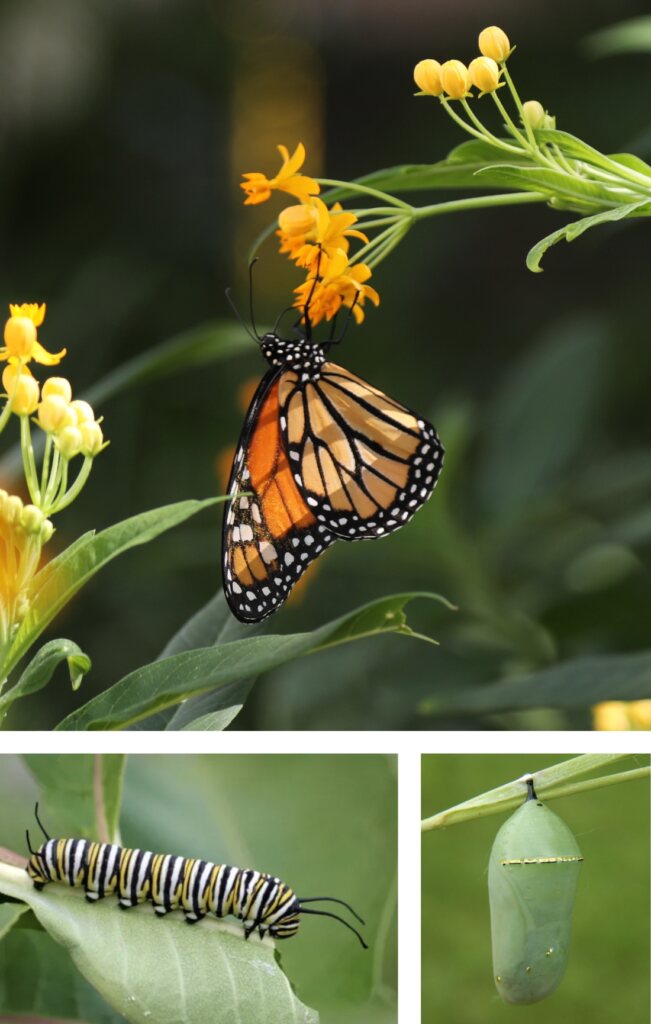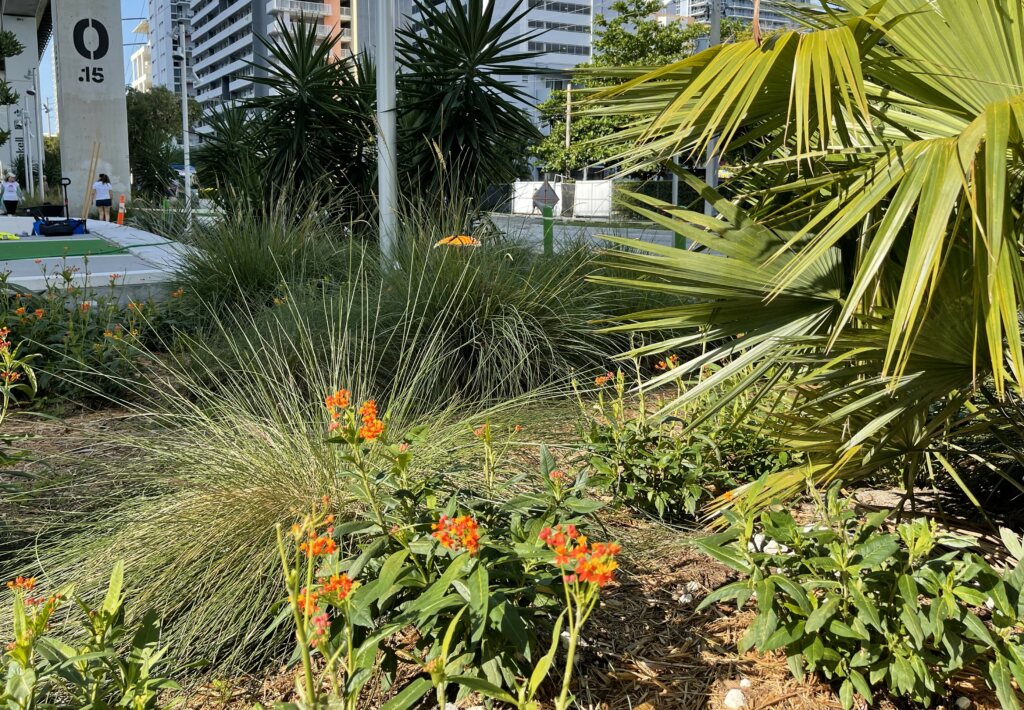Promenade
between SW 10th St and SW 8th St
The Promenade is our busiest part of the park because it is the center of public transportation. Using public transportation options like the Metrorail, Metroover, Metrobus, or trolley is a great way to reduce air pollution in our city!

The Monarch Butterfly
Hello/Hola, I am the Monarch Butterfly (Danaus plexippus).
My striking orange and black wings with white spots and black veins make me stand out.You can find us all through North America. Unfortunately, there are not as many of us as we used to be. We are big butterflies, but we love small flowers. We feed on nectar from many plants that are considered common weeds, like Spanish Needle (Bidens alba). Our caterpillars also love to eat weeds! In fact, Monarch caterpillars can only eat the leaves of a specific group of plants called Milkweed (Asclepias spp.). You might say I’m a picky eater, but that’s okay because we actually have 21 different species of native milkweeds here in Florida! They are called milkweeds because their sap is white like milk, but be careful! Touching the sap of milkweed can irritate your skin.
Migration

Just visiting Miami? Us too! Some monarchs live in South Florida year-round, but some of us make a very long journey crossing up to 2,800 miles! I may look small and delicate, but my wings can take me from Canada all the way down to Mexico and back again! Can you believe that something smaller than the palm of your hand flies across the United States? Isn’t that amazing?
Every winter, it gets too cold for us up in Canada and the northern United States. So, my family and I fly south together all the way to the warmer mountain forest in western Mexico.
We wait in Mexico through the winter from November to mind-March. In the Spring, temperatures become warmer up north and the milkweeds begin to flower again. We fly back north to lay our eggs on the milkweeds, so that when our caterpillars hatch they will have food to grow strong enough to make the same journey again when they become butterflies.
This amazing journey is called “migration”. It’s a long journey, so we need safe places like this to stop for food and rest.
You can help make your home a safe stopping point for us. It’s easy. When you mow your lawn, don’t mow all the weeds. Leave a few for us! We love weeds and the nectar from many of their flowers is an important food source for our long journey home.
Snap a pic! Post your pics and be sure to tag us! #climatechamps @theunderlinemia
Milkweed & Habitat Loss
Sadly, migratory Monarch butterflies were declared endangered in 2021, according to the International Union for Conservation of Nature (IUCN). Not all monarch butterflies are migratory (for example, many in South Florida do not migrate), but those that make the big migration journey across the US take an extra risk.
The reason these butterflies are threatened is because of habitat loss. Habitat loss is when we lose access to the food and/or shelter that we need to keep us safe and healthy. Monarch butterflies can only lay eggs on milkweed plants. Milkweeds grow in disturbed areas like grassy areas along roadways, or within farmland. Unfortunately, these roadside areas are often mowed and the farm land is fertilized, killing the milkweed. When milkweeds are in danger, so are the animals that rely on them for food and shelter, like monarchs.
Luckily there is something you can do. Avoid using pesticides and herbicides. Chemicals may kill unwanted pests and weeds, but they can also harm monarchs, as well as the plants they eat to survive.
And plant milkweed! People like you can plant native milkweed in your yard for monarch butterflies to visit and find the food they need for their caterpillars. Make sure the milkweeds you plant are native to Florida! Non-native species can confuse migrating butterflies and they might not make the journey.
We have twenty-one native milkweed species here in Florida, and several of these are available in nurseries right here in Miami. Milkweeds are also an important food source for many of our other native pollinators, including sweat bees, yellow-faced bees, and leaf-cutter bees. Plant native milkweed today and help create habitat for these beautiful butterflies and other native pollinators!
Injection Wells: Mitigating stormwater
You don’t see them, but you will be glad to know about them after reading this. They are injection wells and they are responsible for sending different types of waste into a deep storage place underneath the ground. Injection wells began to be widely used in the 1930s when oil companies looked for ways to dispose of brine. They are an economical and safe way to dispose of hazardous byproducts because they do not pose any risk to the groundwater that sits above it.
Injection wells are monitored by the Environmental Protection Agency (EPA) and have 6 classifications (I, II, III, IV, V and VI). Each class is designed to store a different type of waste. The most common type is a class V injection well, which stores non-hazardous fluids like stormwater. They are like giant tubes that are dug into the ground. Think of them as the Earth’s underground storage tanks. They work by injecting waste materials like stormwater deep beneath the Earth’s surface.
Why is this important? Many areas in the Brickell area are prone to flooding because of low elevation and street drainage capacity. Stormwater collects all kinds of pollutants and litter from road surfaces and carries it through gutters and eventually to our natural bodies of water like lakes, rivers, and the ocean. The injection wells collect large amounts of stormwater and funnel it deep underground, reducing the amount of potential pollutants to our waterways. This helps protect The Underline and neighboring streets from flood conditions, and keeps our waters safe from chemicals.

